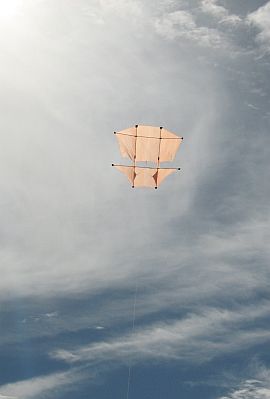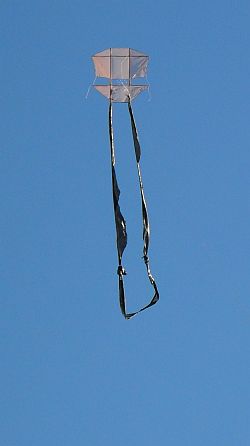- Home Page
- Flight Reports
- Sticked Doperos
- Skewer Dopero
Skewer Kite Posts—Dopero
(Bamboo BBQ Skewer Spars)
It's an archive of sorts, although there are no dates and times. Kite flying is timeless, don't you agree?
I trust there is plenty in here to educate, inform, and often entertain!
These short flight reports once appeared as posts in the site-blog page although that page is no longer present on this site. Below, the latest posts come first. Just scroll down and stop at any heading that appeals. :-)
2-Skewer Dopero Kite
Dopero Darts and Dives
So would most kites, with winds averaging 13 kph but gusting to 33 kph! Those were the figures shown by holding up the Windtronic meter for a minute or two.
 MBK 2-Skewer Dopero
MBK 2-Skewer DoperoAll the same, the venerable 2-Skewer Dopero kite held up well in the fan-forced oven that was the weather this afternoon. It wasn't the hottest we've had over the last week or two, but at over 35 degrees Celsius it was quite warm enough! I was curious to try the quite small dopero right up near the top of its wind range.
On selecting the kite from a few other 2-Skewer Series designs displayed around our house, I noticed something. The kite had been somewhat refurbished with clear tape over all the spar tips. Good! The only question was—how would the old sail plastic hold up under high wind-pressure?
A bit of flying on a short line revealed a slight tendency to turn left during gusts. With the tiniest of adjustments to the upper bridle knot, the kite was away again. This time I let out over 30 meters (100 feet) of 50-pound line. Normally, this kite is flown on 20-pound line, but today it had no trouble pulling the heavier stuff straight!
The kite's trim turned out to be almost spot on, with the kite being forced all the way to the ground first in one direction and then in the other. That's flying on the edge! Contacts with the ground were fairly soft, though, right at the sides of the flying window. But for much of the time, the little dopero darted about most impressively—at high angles—soaking up fresh bursts of very thermally active air.
The sails? Ummm yes, short splits had appeared in a couple of places, so I called it quits rather than do more damage. I suspect the main sail corner-ties had pulled through a little as well, about the same amount on each side.
Here at home,
an online check of wind speeds returned 22 kph gusting to 35 kph at a
location not far from the field. So that was one light-wind dopero tested to the
very limit!
On this site, there's more kite-making info than you can poke a stick at. :-) Want to know the most convenient way of using it all?
The Big MBK E-book Bundle is a collection of downloads—printable PDF files which provide step-by-step instructions for many kites large and small.
That's every kite in every MBK series.
2-Skewer Dopero Refit
Looking at the online weather site (and out the window) there appeared to be ample breeze to fly.
Why not take yet another Skewer kite? Hence the 2-Skewer Dopero was selected, since it would be tolerant of heavier gusts.
But before heading out, a quick check revealed that this old kite needed some attention.
The next half an hour was spent doing a refit. All the electrical tape at all eight spar tips was carefully peeled off and replaced with clear sticking tape. This was a bit of an experiment, since so far I have only used sticking tape spar-caps for the 1-Skewer Series kites.
The upper and lower bridle knots were adjusted to center. Also, one sail tie had pulled out.
Down at the reserve, the sky was overcast with dark patches. Active air! Indeed, moderate-strength gusts were pummeling the trees every few minutes.
For a while, the pale-orange craft flew on 30 meters (100 feet) of line. There were hints of instability, with the kite racing to and fro and even going right over into a loop and landing at times. And it wasn't always to the same side!
I realized that removing heavy electrical tape had probably shifted the balance point a little toward the nose. So the kite was certainly nice and light but evidently too nose heavy to fly reliably near the top of its wind range. So I added two strips of electrical tape right across the trailing edge of the central portion of the lower sail.
The dopero now did much better in the air!
Then followed an amazing flight on 60 meters (200 feet) of 20-pound Dacron. The kite was steady much of the time but pulled hard and shifted left and right as stronger gusts in the mid 20s (kph) came through. The twin keels were quick to kick the nose back into wind.
Delta-like flying angles were seen, but with more tolerance of high wind-pressure than an equivalent delta or diamond.
Finally, during lulls, I wound line on to the block winder to bring the kite down. It wasn't a bad little outing!
1-Skewer Dopero Kite
Tiny Dopero Still Terrific!
Once again, I went out for a short fly today, taking an old Skewer Series kite.
I literally had to reach through cobwebs to retrieve the dusty 1-Skewer Dopero kite! This one was the original with a black plastic sail and dinky little yellow plastic keels. The kite is around ten years old at this writing.
 MBK 1-Skewer Dopero
MBK 1-Skewer DoperoDown at a local elementary (primary) school field, the dopero was easily popped up into the moderate-strength gusts blowing across the grass. It soon became clear that the kite was looping to the right under pressure. Hence a minuscule adjustment was made, shifting the upper bridle knot to the left. But it was not by more than a couple of millimeters.
With better trim, the 1-Skewer Dopero sailed around happily on about 15 meters (50 feet) of 20-pound Dacron line. A prolonged gust then sent the tiny black craft all the way to the grass in a graceful wide arc. Surprisingly, another gust cartwheeled the kite sideways for a few turns before it took off again, soaring high!
There was a large bushy tree not far away, just waiting to trap the kite. So it was decided to move across to a more open section of the field. This time, around 50 meters (160 feet) of line went out as the tiny kite raced around the sky, often disappearing as it aligned with the late-afternoon sun. Much of the time, high up in smooth air, the small black craft hung off to the left. So yet another very tiny adjustment of the sliding bridle knot was required to get perfect balance. With kites this size, knots are shifted a mere millimeter or two to make a big difference to the flight characteristics.
With the knot done and the winder trapped behind my kite bag, the dopero was lifted up to catch the breeze. Soon the kite was straining away and climbing like a lift on the full length of the line.
What followed was the most amazing flight I think this little kite has ever displayed! It raced left and right, climbed to high angles, and descended tail first, depending on the breeze strength. Due to its small size, though, the dopero never quite straightened out the line—despite pulling its hardest.
No wind-meter readings were taken; I was far too engrossed in watching the aerial action! :-)
Diminutive Dopero Delivers
It delivered some material for a short-format flight report, that is! After a few unsuccessful launch attempts in tricky light air, the tiny 1-Skewer Dopero kite finally put on a nice climb and float for the camera.
It'd been a while since this kite had flown, and one of the upper sail ties had to be repositioned. That's not to mention a layer of fine dust that had to be blown off the black plastic.
Being such a
small kite, these very minor changes managed to put the trim off
somewhat, causing a pull to the left in gusts. Or perhaps the bamboo
frame had warped slightly from so many months sitting on a shelf.
The
trim problem was enough to foil the first few attempts to get more than
several meters of 20-pound Dacron out. After a couple of little tweaks
of the bridle Prusik knots, the little black kite was left with just a
hint of a pull to the right. This was close enough, though, to get some
useful video of a half-minute flight on perhaps 15 meters (50 feet) of
line.
I can recommend black-plastic sails teamed with yellow keels for any homemade delta, roller, or dopero kite. It looks good, and the kite is highly visible against just about any skyscape—cloudy, gray, or pure blue.
The story or stories above document actual flying experiences. My write-ups are definitely "warts and all," since things don't always go totally as planned. However, half the fun of kiting is anticipating the perfect flight. When it happens, it's magic!
As mentioned earlier, there's more kite-making info here than you can poke a stick at. :-)
Want to know the most convenient way of using it all?
The Big MBK E-book Bundle is a collection of downloads—printable PDF files which provide step-by-step instructions for many kites large and small.
That's every kite in every MBK series.
